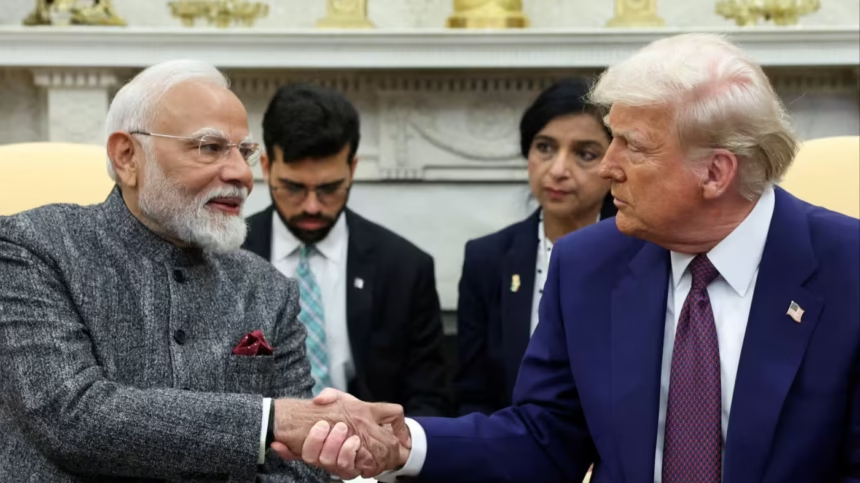Please use the sharing tools found via the share button at the top or side of articles. Copying articles to share with others is a breach of FT.comT&Cs and Copyright Policy. Email licensing@ft.com to buy additional rights. Subscribers may share up to 10 or 20 articles per month using the gift article service. More information can be found here.
https://www.ft.com/content/390be64a-1527-4f71-a322-59af41133914
Donald Trump has described India as a “dead economy” and said the US does “very little business” with the country, ratcheting up his fiery rhetoric against the world’s fifth-largest economy as the two sides hit an impasse over his threat of 25 per cent tariffs on Indian goods. The US president, writing on his Truth Social platform early on Thursday, attacked India alongside its long-standing defence and trade partner Russia, after warning a day earlier that he would penalise New Delhi for buying Russian weapons and energy. “I don’t care what India does with Russia,” Trump wrote. “They can take their dead economies down together, for all I care. “We have done very little business with India, their Tariffs are too high, among the highest in the World,” he added. India and the US traded goods worth more than $129bn in 2024, and the US is India’s largest trading partner. The two countries have also built a strategic relationship on defence, technology, and other areas, based in large part on a shared desire to contain China. But New Delhi is also the second-largest buyer of Russian oil by value, after China, and Moscow remains its main source of arms, though Indian governments including that of Prime Minister Narendra Modi have sought to diversify its weapons procurement in recent years, including from France, the US and Israel. India’s blue-chip Nifty 50 stock index slipped 0.3 per cent on Thursday after the tariff level was announced. The rupee was little changed after initially falling 0.3 per cent against the dollar to a five-month low. The 25 per cent tariff — which is just one percentage point lower than the rate Trump initially unveiled on his “liberation day” in April — is set to take effect on 1 August. But Indian officials have not confirmed receipt of a letter from Washington formally notifying them of the move, and Trump later on Wednesday suggested the sides were still in negotiations, telling reporters: “We’ll see what happens.” The stand-off leaves India as a relative outlier after the EU, Japan, South Korea and others have bowed to Washington’s tariff pressure and agreed trade deals. Modi’s government on Wednesday said it would “take all steps necessary to secure our national interest”. Analysts at Mumbai-headquartered Axis Bank estimated the 25 per cent tariff would have a $10bn incremental impact on Indian exports, even though the country’s economy is largely domestically driven. Kunal Kundu, India economist at Société Générale, said the tariffs could “dampen domestic sentiment”. “India’s expectation of maintaining a relative tariff advantage over competitors in labour intensive exports has been undermined,” he said. “However, the disadvantage is not excessively severe.” The US president’s comments on India and its relationship with Russia will further inflame bilateral tensions at a time when many Indians are angry over Trump’s remarks about Pakistan, following a brief military conflict between the south Asian adversaries in May. Trump on Wednesday also announced a deal with Pakistan that would involve “developing their massive Oil Reserves”, adding: “Who knows, maybe they’ll be selling Oil to India some day!” in remarks that appeared designed to annoy Indians. Recommended Business InsightPatrick Jenkins What India’s economy can teach the UK According to people briefed on the talks in New Delhi and Washington, India’s tough stance on protecting its foodgrain and dairy markets was a big sticking point. India did not want to open the markets, on which hundreds of millions of people rely for their livelihoods, to US competition. India’s largest single export to the US is mobile phones, thanks in large part to Apple’s recent push to relocate production of US-bound iPhones from China. Electronics including smartphones, as well as pharmaceuticals, were exempt from Trump’s original “reciprocal tariff” threat. “Smartphones aren’t impacted by the new US tariffs yet, but if that changes and India can’t secure relief, Apple may rethink its US pricing,” said Sanyam Chaurasia, principal analyst at Canalys, part of Omdia. “Shifting production won’t be easy, and returning to China carries greater risk, so Apple is likely to stay invested in India.”







